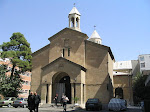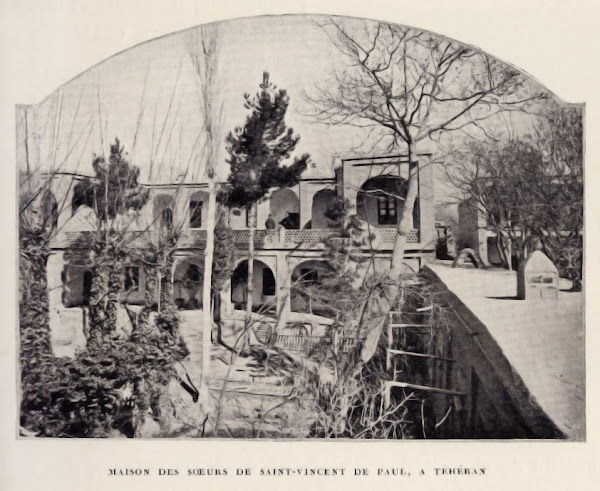Introduction
Throughout the world women pride themselves on being alumni of Jeanne d’Arc schools. From Canada to Indochina, Jeanne d’Arc schools were mostly, but not exclusively established in the French influence sphere. They provided a western, multilingual education and upbringing to daughters of European expatriates, Christian minorities and local elites. But for the Iranian alumni, the recollection of the time spent at the Tabriz, Esfahan or Tehran Jeanne d’Arc schools takes on a particular meaning. Many of the “Jandarki” have since left Iran to build their lives abroad, often very successfully so. Today they hold very dear recollections of the school which provided them with the linguistic as well as the social tools to integrate and prosper in places like Los Angeles, Toronto, Paris or London to name but a few. They also long to perpetuate the strong ties that once bound them as youngsters despite their geographical dispersal. This is an attempt to briefly outline the history of the Tehran Jeanne d’Arc school, so as to provide enthusiastic alumni with information which is not always readily available.
Early foreign missions and schools in Persia
The origins of the Jeanne d’Arc school go all the way back to the European Middle Ages when Dominican and Franciscan monks established the very first Christian missions in the Persian Empire. But it is not until the early 17th century that Shah Abbas I Safavi, who eagerly sought European support in his efforts to counter Ottoman expansionism, welcomed official representatives of monastic orders such as the Augustines, Jesuits and Carmelites to establish religious centers for European Christians who were coming to Persia in increasing numbers. Two schools were opened in Esfahan to teach European languages.
But there wasn’t much left of these by the time the British and the Americans started sending protestant missionaries to Persia around 1830. Among others, a Methodist missionary from Boston, Justin Perkins, settled in Persian Azerbaijan around 1833 at the demand of the Assyrian (or Nestorian) Christian minority of Tabriz. Typically, Westerners would come to the rescue of Middle Eastern Christian minorities whom they considered to be discriminated against by Muslim rulers. But Perkins had taught English to the Shah’s uncle Malek Qazem Mirzâ and in 1839 he managed to obtain an imperial firman from Mohammad Shâh Qâjâr, granting him official authorization to run a school in Tabriz.
The French presumably weren’t very happy about the protestant presence among Persian Christians. The French minister of education and the Académie des Inscriptions et Belles-Lettres, an organization which was to elevate the prestige of the French monarchy and which specialized in the study of non-European civilizations, sent the devout Catholic layman and multilingual orientalist, Eugène Boré, on a scientific mission to Tabriz in 1838. By 1840, Boré had personally financed two schools for Armenian and Muslim children in Persia, one in Tabriz and one in Djolfa in the outskirts of Esfahan. This was the first time pupils of two different religions were brought together in one school in Persia. In 1839, Boré joined a French diplomatic mission led by Félix Édouard Comte de Sercey, the new French ambassador to Persia. The Persian government welcomed the French presence as relations with England were strained over the occupation of Herat in 1838 and with Russia over the construction of port facilities at Anzali. France on the other hand wanted to break the British hegemony over world trade and wished to strengthen its presence in Persia. Another imperial firman from Mohammad Shâh Qâjâr, granted Roman Catholics permission to open schools in Persia. Furthermore, the Shah assigned Boré the education of the crown prince, the future Nasr ed-Dîn Shâh. The time was ripe for Boré to invite French Lazarist missionaries to Persia. The first ones would arrive in Tabriz the very same year.
Origins of the Lazarist missionaries and the Daughters of Charity
The Lazarists were founded in 1625 by St. Vincent de Paul (1581-1660). They are also known as the Congrégation de la Mission but have been named after their monastery which was established in the Paris parish of St Lazare. Vincent de Paul’s life work consisted of practicing charity to re-Christianize abandoned parishes and oppose budding protestant missions. He received support from Louise de Marillac (1591-1660) who founded the congregation of the Daughters of Charity (Filles de la Charité) in 1633. From then on Lazarists and the Daughters of Charity would often share missionary work. The founding principle of the St. Vincent de Paul congregation consisted of « évangéliser les pauvres et former le clergé ». It was also said that « Ils ont aussi la joie profonde de faire aimer mieux et plus loin la France » !
The Lazarist mission in Iran
The Lazarist missionaries established a mission in Tabriz, soon to be followed by settlements in Urumieh, Khosroabad and Esfahan, near the main Christian (Armenian, Chaldean, Nestorian) minority quarters. Their aim was to « raviver la foi et ramener au bercail ces communautés égarées ». They built schools and churches and were so successful that the American protestant mission and the local Armenian and Nestorian clergy, fearing a loss of influence, started to oppose the French monks. But the French Embassy approached the Imperial government to support their missions. Also the local Persian governor of Urumieh, Malek-Qâsem Mîrzâ, who spoke fluent French and was a member of the Société Asiatique in Paris, intervened in their favor. Despite the competition with the Protestants, the Lazarists were appreciated for their relative neutrality, which is why they were granted special protection during the Armenian genocide at the Persian-Ottoman border. The Russians and the British however were exceedingly hostile to the imposition of the French school system. This culminated in 1911 when the Russian occupying army in Tabriz hung the local school principal. Many such events which illustrate the difficulties the Lazarist schools experienced during the many wars and revolutions which swept Iran could be recounted. But such is not the purpose of this article. It must be noted that despite great difficulties many schools were founded throughout the 19th and 20th centuries including in Sanandaj, Naqada, Khorramshahr and Qasvin, besides a summer camp at Noshahr. French schools, along with their American, British, German, and Russian counterparts, were the main channels through which modern elementary and secondary education were brought to ethnic minorities and middle class Persians for almost a century extending from the 1830s to 1920s. Catholic schools were established by Lazarist missionaries, Jewish schools by the Alliance Israélite Universelle, and lay schools by the Alliance Française.
The Lazarist mission in Tehran was established in 1862, 22 years after the initial arrival of the Lazarist missionaries in Azerbaijan. Tehran allegedly counted a mere 1000 Christians out of 180.000 inhabitants, 700 of whom were Armenians. The remaining 300 consisted of Embassy personnel, military instructors and engineers, 80 of whom were Roman Catholics who « manquaient presque de tout secours religieux ». Obviously Tehran was not as important to the Catholic missionaries as Urumieh, which would remain the principal mission location. At least until the railway to the Caspian would be finished (not until 1938) so a junction could be made with the Christian communities to the north and Europeans could more easily travel from Baku and Anzali to Tehran through the Alborz range. Lazarist father Plagnard nevertheless bought a property in Tehran, presumably on what is today Mirza Kuchak Khan Avenue and built a church which would become the center of the future European quarter of Tehran. The Tehran St Louis school for boys was established the same year, enrolling 15 both Christian and Muslim pupils. It was the first Catholic Mission school to be established in Tehran. Compared to their counterparts in Azerbaijan and Isfahan, St Louis was more concerned with educating pupils in modern sciences and French literature than in religious matters. In 1909 the enrollment was 140 pupils and by 1952 it counted no less than 530 pupils.
The Daughters of Charity mission in Iran
But what about the girls ? After the Lazarists had started their boys’ schools in Azerbaijan, they noticed the protestant missions were opening schools for girls as well. In order to counter this competition the Lazarists requested the presence of their female peers, the Daughters of Charity to open a girls’ school. In 1856 they approached sisters who had served as nurses in the Crimean war and now resided in Constantinopel (the future Istanbul). Eight of them settled in Khosroabad and Urumieh (and later in Salmas, Tabriz and Qasvin) and founded a girls’ school, an asylum, an orphanage and a medical consultation. All services were available for Moslems too which made the Daughters of Charity very popular. Nasser ed-Dîn Shâh granted them with a yearly allowance. A girls’ school was established in Jolfa (Esfahan) in 1904 with 115 students; it was later renamed the Rûdâbeh School. In 1963, the school was visited by General de Gaulle who lauded the Daughters of Charity for their efforts. Before it was closed in 1979, Rûdâbeh had twelve grades together with kindergarten.
The Tehran Jeanne d’Arc School
The origins of the Tehran Jeanne d'Arc school can be traced to two different St. Vincent de Paul schools.
The first one was a school for orphaned girls founded on Manûchehrî street, in the vicinity of the Lazarist church, by the Daughters of Charity in 1865. In the 1920s, the school provided both primary and secondary education to separate classes of Muslim and Armenian pupils. The Ministry of Education granted the school one hundred tomans per month to support needy students and for the teaching of Persian.
The second school was St. Joseph, a four-year elementary school for girls founded in 1880 in the Armenian neighborhood near the Qazvin Gate (today’s Vahdat Square). Later, the school admitted boys in separate classes. The school had ninety-nine girls and thirty-three boys in 1929.
In the 1930s the two schools would gradually be united. From 1931 on, Sister Pauline became the principal of both the Jeanne d'Arc and St. Joseph schools. Later, in the mid-1930s, the school was renamed Manûchehrî Elementary and High School. In the late 1930s it had an enrollment of about one hundred pupils and ten teachers. Archival sources show that the daughters of the Belgian customs officials in Iran attended the school in those days. In 1941 the Persian program was closed, but the French program continued for foreign pupils. In 1953, the Persian program was revived and the school name changed to Jeanne d'Arc with Mrs. Badr-al-Molûk Pâzârgâdî as its principal. In the early 1960s, it had about a thousand pupils in the secondary school which only covered education until the tenth grade, after which many of the more affluent pupils were then sent abroad to finish their studies or to Lycée Razi which offered mixed classes for boys and girls up to the twelfth grade. Later in the 1960s, the two last grades became available at Jeanne d’Arc.
The Tehran Jeanne d’Arc school was closed in 1980. Most of the Daughters of Charity left Iran and the remaining pupils were relocated at Lycée Razi which itself was closed the following year.
____________________
Warning
This article is not based on genuine hard archival facts but rather on a collection of witness accounts and articles of varying quality. Readers are very welcome to suggest corrections to the Facebook group “Ecole Jeanne d'Arc, Téhéran - Class of '83”. It would be nice if those could be backed up by hard documented evidence or firsthand witness accounts. Thank you.








